1987 | OriginalPaper | Buchkapitel
Remote Sensing Studies of Oceanic Cloud-Radiation Feedbacks
verfasst von : Beth Chertock, Sam Lacobellis, Richard C. J. Somerville
Erschienen in: Atmospheric Radiation
Verlag: American Meteorological Society
Enthalten in: Professional Book Archive
Aktivieren Sie unsere intelligente Suche, um passende Fachinhalte oder Patente zu finden.
Wählen Sie Textabschnitte aus um mit Künstlicher Intelligenz passenden Patente zu finden. powered by
Markieren Sie Textabschnitte, um KI-gestützt weitere passende Inhalte zu finden. powered by
Multi-year time series of earth radiation budget (ERB)parameters have recently become available from the Nimbus-7 satellite. These data permit an assessment of the natural variability of the measured parameters, including earth albedo, longwave terrestrial flux, and net radiation.Additionally, the satellite ERB data provide a promising means for validating several proposed cloud-radiation feedback mechanisms. One such feedback is due to the possible dependence of cloud optical thickness on temperature. Other feedbacks involve the possible systematic dependence of cloud height and cloud amount on variables such as temperature and relative humidity.Clouds respond rapidly to their environment. so an analysis of how they change as sea surface temperature(SST)undergoes an annual cycle may provide clues as to how they will respond to a long-term SST change like that due to CO2 increases. Statistical effects of SST variability may be sought in time and space averages of satellite ERB data. These effects vary with geographical region, synoptic regime and other factors. It would be naive to regard seasonal and interannual variability as a simple surrogate for longer-time climate variability. Nevertheless, physical processes which are important in oceanic cloud-radiation feedbacks may occur on a wide range of time scales, including those accessible through the Nimbus-7 data.An additional aim of our work is to better document the regional and temporal variability of ERB parameters. We have carried out preliminary analyses in several test regions. Both the planetary albedo and SST in our test regions show substantial interannual and seasonal variability. Furthermore. the SST and albedo time series sometimes display similar features. For example, the envelopes which bound the variability of the two curves may have similar structures. These albedo changes over the oceans are presumably due entirely to cloud variability. Therefore, our preliminary results suggest that under some circumstances cloud parameters, and hence cloud effects on earth radiation budget components, may vary systematically with sea surface temperature.We have also employed a hierarchy of models to interpret the satellite data and use them to assess the present state of the art in taking cloud-radiation interactions into account for large-scale numerical weather prediction and climate simulation.
